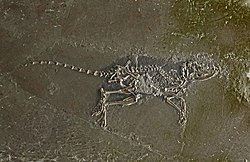Portal:Paleontology
The Palaeontology Portal Introduction Paleontology (/ˌpeɪliɒnˈtɒlədʒi, ˌpæli-, -ən-/ PAY-lee-on-TOL-ə-jee, PAL-ee-, -ən-), also spelled palaeontology or palæontology, is the scientific study of life that existed prior to the start of the Holocene epoch (roughly 11,700 years before present). It includes the study of fossils to classify organisms and study their interactions with each other and their environments (their paleoecology). Paleontological observations have been documented as far back as the 5th century BC. The science became established in the 18th century as a result of Georges Cuvier's work on comparative anatomy, and developed rapidly in the 19th century. The term has been used since 1822 formed from Greek παλαιός ('palaios', "old, ancient"), ὄν ('on', (gen. 'ontos'), "being, creature"), and λόγος ('logos', "speech, thought, study"). Paleontology lies on the border between biology and geology, but it differs from archaeology in that it excludes the study of anatomically modern humans. It now uses techniques drawn from a wide range of sciences, including biochemistry, mathematics, and engineering. Use of all these techniques has enabled paleontologists to discover much of the evolutionary history of life, almost back to when Earth became capable of supporting life, nearly 4 billion years ago. As knowledge has increased, paleontology has developed specialised sub-divisions, some of which focus on different types of fossil organisms while others study ecology and environmental history, such as ancient climates. (Full article...) Selected article on the prehistoric world and its legaciesCoal balls, despite their name, are calcium-rich masses of permineralised life forms, generally having a round shape. Coal balls were formed roughly 300 million years ago, during the Carboniferous Period. They are exceptional at preserving organic matter, which makes them useful to scientists, who cut and peel the coal balls to research the geological past of the Earth. In 1855, two English scientists, Joseph Dalton Hooker and Edward William Binney, discovered coal balls in England, and the initial research on coal balls was carried out in Europe. It was not until 1922 that coal balls were discovered and identified in North America. Since then, coal balls have been discovered in other countries and they have led to the discovery of over 300 species and 130 genera. Coal balls can be found in coal seams across North America and Eurasia. North American coal balls are relatively widespread, both stratigraphically and geologically, as compared to coal balls from Europe. The oldest known coal balls were found in Germany and the former Czechoslovakia. Did you know?
General images -The following are images from various paleontology-related articles on Wikipedia. Selected article on paleontology in human science, culture and economicsGould's most significant contribution to evolutionary biology was the theory of punctuated equilibrium, which he developed with Niles Eldredge in 1972. The theory proposes that most evolution is marked by long periods of evolutionary stability, which is punctuated by rare instances of branching evolution. The theory was contrasted against phyletic gradualism, the popular idea that evolutionary change is marked by a pattern of smooth and continuous change in the fossil record. Most of Gould's research was based on the land snail genera Poecilozonites and Cerion. He also contributed to evolutionary developmental biology, and has received wide praise for his book Ontogeny and Phylogeny. In evolutionary theory he opposed strict selectionism, sociobiology as applied to humans, and evolutionary psychology. Gould was known by the general public mainly from his 300 popular essays in the magazine Natural History, and his books written for a non-specialist audience. In April 2000, the US Library of Congress named him a "Living Legend". (see more...) On this day...Selected image
CategoriesTopicsGeneral - Paleontology - Fossil - Evolution - Extinction Quality ContentFeatured paleontology articles
- Achelousaurus
- Acrocanthosaurus
- Albertosaurus
- Allosaurus
- Amargasaurus
- Ankylosaurus
- Apatosaurus
- Archaeopteryx
- Baryonyx
- Carnotaurus
- Catopsbaatar
- Ceratosaurus
- Chicxulub Crater
- Compsognathus
- Cretaceous–Tertiary extinction event
- Daspletosaurus
- Deinocheirus
- Deinonychus
- Deinosuchus
- Dilophosaurus
- Dinosaur
- Diplodocus
- Dromaeosauroides
- Edmontosaurus
- Elasmosaurus
- Giganotosaurus
- Gorgosaurus
- Herrerasaurus
- Iguanodon
- Istiodactylus
- Lambeosaurus
- List of dinosaur genera
- Majungasaurus
- Massospondylus
- Megalodon
- Nemegtomaia
- Nigersaurus
- Opisthocoelicaudia
- Paranthodon
- Parasaurolophus
- Plateosaurus
- Psittacosaurus
- Seorsumuscardinus
- Spinosaurus
- Stegosaurus
- Stegoceras
- Styracosaurus
- Tarbosaurus
- Thescelosaurus
- Triceratops
- Tyrannosaurus
- Velociraptor
Things you can doCurrent Paleontology FACs - None yet... WikiProjectsRelated portalsAssociated WikimediaThe following Wikimedia Foundation sister projects provide more on this subject:
Discover Wikipedia using portals |










































